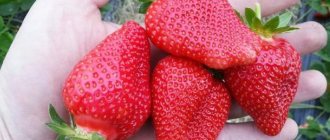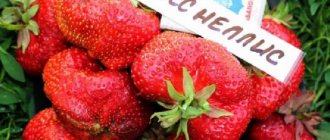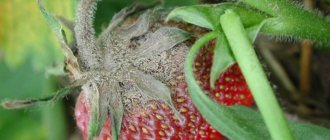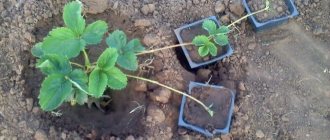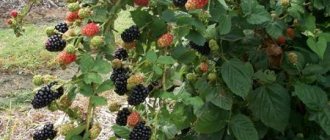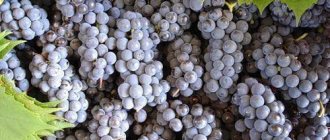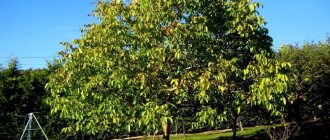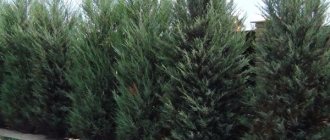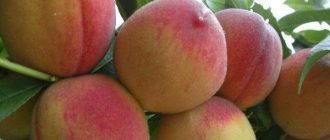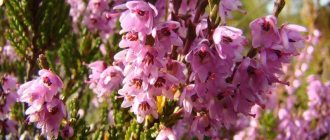Is it possible to divide strawberry bushes?
There are varieties of strawberries that are reluctant to form mustaches. These are mainly remontant species and selection hybrids that do not form them at all, for example, Snow White, Raymona, Veska, Profuzhen, Ali Baba. For such strawberries, another method of propagation is provided - by dividing the bush, which completely preserves the varietal characteristics.
This method is only suitable for absolutely healthy strawberry bushes with a developed root system. Pre-marked plants should be carefully examined for diseases, signs of damage by insects and other pests. If this is not done, then the new planting material will “inherit” the problems.
Dug up strawberry bush
The main advantage of propagating strawberries by dividing an adult bush, as opposed to propagating with seeds and tendrils, is simplicity and accessibility. The method is perfect for increasing plantings of scarce varieties. Other benefits:
- You can renew berry beds for a long period - from mid-spring to mid-autumn.
- Unlike propagation by mustache, you can first get a harvest, and then start dividing the bush.
- Since the horn (a bush with a root) is part of an adult plant, it will be able to bear fruit as early as the next season.
- High survival rate of young seedlings (up to 90%).
- By choosing healthy, vigorous rosettes for division that produce large berries, you work to increase your yield year after year.
The most common varieties
Today there are quite a lot of varieties of wild strawberries. And if it is almost impossible to purchase seedlings, then the seeds are sold at any garden center. You can choose the appropriate variety based on the description on the bag or the color of the fruit.
The most common red-fruited varieties are: “Alexandria”, “Baron Solemacher”, “Gross Fraser”, “Ruyana”, “Regina”, “Rügen”, “Rote Solemacher”. Yellow-fruited - “Holiday”, “Zolotinka”, “Yellow Miracle”. Of the white ones, the most popular are “Snow White” and “Weiss Solemacher”.
Strawberry beardless "Alexandria". © National Gardening Association
Wild strawberry "Weiss Solemacher". © s-lopatoy.
Strawberry beardless "Yellow miracle". © rastenia-biolit
Dear readers! Strawberries are a completely simple plant to care for, and therefore are suitable not only for experienced gardeners, but also for beginners. At the same time, to get acquainted, you can plant just a few bushes of this amazing plant. And only then, if he likes it, allocate a larger territory to him. But even if you don’t have room for these unusual strawberries, these first 3-5 bushes are enough to enjoy the aromatic berries throughout the summer season.
How to propagate strawberries by dividing rosettes
The best time to propagate strawberries by dividing rosettes is the first half of August. At the same time, you can divide the bushes throughout the growing season. In the new location, the sockets take root quickly, already in mid-September. The optimal age for selecting mother bushes and dividing them is 2–4 years. Bushes that are too young have few horns, and old ones don’t bear fruit well.
The process of dividing a strawberry bush
From one mother bush you can get 5–15 new specimens. It is important that each of them has several roots. Step-by-step instruction:
- Carefully dig the selected bush out of the soil. If possible, save the earthen ball so as not to damage the roots.
- Pick off dry and yellow leaves. Place the plant in a bowl of water at room temperature. You can add a few crystals of potassium permanganate until it turns pale pink for disinfection.
- When the soil settles from the roots to the bottom of the basin, you can begin to divide the bush. Try to unravel the roots with your hands, without scissors or a knife. Do not pull too hard to avoid damaging the socket. If the roots cannot be separated with your fingers, use only a sharpened and disinfected tool.
- Dry for an hour and periodically inspect the roots. Those that show even the slightest traces of mold, rot, as well as dry and dark cut ones are not suitable for propagation. Sprinkle the cut areas with crushed activated carbon, chalk, wood ash and cinnamon powder.
- Replant new sockets in the chosen location. To stimulate the growth of the root system, each leaf is cut in half.
Planting seedlings for growing
Strawberry bushes being grown
New horns can be planted in a permanent place immediately after division. There is always a risk that the seedlings will not take root or will produce a meager harvest. Experienced gardeners, in order for the bushes to take root faster and form an adult rosette, plant the horns in pots for growing. Work order:
- Prepare pots with a diameter of 8–10 cm for each horn.
- Fill them two-thirds with garden soil mixed with peat in a 1:1 ratio.
- Place a strawberry cone in the center.
- Cover it with soil on all sides so that the outlet remains open.
- Water the soil in the pots thoroughly.
- Transfer the pots to a greenhouse for 1.5 months.
After planting for growing, it is important to properly care for the strawberry bushes. For 1.5 months, you need to maintain high humidity in the pots and prevent the earthen ball from drying out. Without this, fragile roots will lack moisture, which will slow down their development. To maintain moisture levels, use mulch, such as sawdust, peat, chopped straw.
Fertilizing a strawberry bush
If it is very sunny in a greenhouse with propagated strawberries, then you need to provide partial shade to the horns. This will reduce water evaporation from the leaves. For better formation of the aboveground part and its root system, complex fertilizer is applied. Strawberries especially love potassium supplements.
Transplantation to a permanent place
The readiness for transplantation of young bushes is determined by their strong and fleshy leaves. You need to prepare for planting in the beds in advance. Step-by-step algorithm:
- Dig up the soil in about a week.
- Dig holes using a 40x40 cm pattern.
- Fill each hole halfway with humus (a bucket of organic fertilizer can be mixed with 2 cups of wood ash and 30 grams of superphosphate and fill the holes with this mixture)
- Transfer the seedlings from the pot to the hole, the rosette should be on the surface of the soil (it cannot be covered with soil, otherwise the bush will die).
Propagation of remontant strawberries by seeds
To get 1 gram of seeds, you will need 1.5 kg of strawberries. The optimal time to collect berries for seeds is late June-early November. The largest berries need to be left on a plate and wait until the seeds are completely ripe. Then you need to place the fruits in a jar for 12 days and stir periodically.
After this time, a mass in the form of jelly is formed in the jar. Next, you need to pour water into the jar and rinse the seeds several times, while they will settle to the bottom of the jar. Then you should put the seeds on a cloth and dry them in the sun. After they are dry, put them in a bag and store them at a temperature of 12 degrees until sowing.
Before sowing, the seeds are disinfected with a solution of potassium permanganate. After sowing the seeds in the box, you need to moisten the soil with a weak solution of manganese.
Boxes for sowing are filled with turf soil mixed with sand (1/4 part); peat drainage should also be done. Next, you need to level the surface and lay the seeds, sinking them into the ground.
After all the seeds are sown, you need to pour a small layer of sand (about 1 cm) on top. To prevent mice or rats from getting to the seeds, it is advisable to cover the box with thick paper and sprinkle a layer of crushed peat on top.
Caring for young seedlings
After transplanting strawberries obtained by dividing a bush, proper care is important so that they take root as much as possible and take root before winter. During the first two weeks, young bushes need to be protected from direct sunlight. Regular and abundant watering is required. Retain soil moisture by mulching. The covering material will save the gardener time on weeding the beds.
Watering strawberry bushes after dividing
A month after planting, it’s time to feed the strawberry bushes with potassium sulfate or other complex fertilizer for berries. Careful hilling promotes more active root formation. To help the berry survive the winter better, you can cover it with spruce branches until severe frosts or the first snow.
Choosing a place and landing
Strawberries bear fruit well in areas where there is a lot of sunlight. To prevent her from getting severe burns, a little shading is required - for this there should be shrubs or dwarf trees around. Since strawberries must grow for at least 3 years, fast-growing plants should not be placed around them.
The most popular way to plant strawberries is in rows, at a distance of 60-80 cm from each other, and the distance between plants is about 40 cm. You can also use a square planting - in which the plants are located at a distance of 50x50 cm in 4 rows.
Before planting, the roots of strawberries should be straightened and sprinkled with earth, but it is advisable to replant them with a lump of earth. Strawberries should be planted in the evening or early in the morning, preferably before the rain, so that it waters the new plants abundantly.
Why strawberries don't take root well
The main reason why strawberries do not take root well is unprepared soil. Substances remain in it after the growth of other crops. This makes it difficult for strawberries to feed, develop and bear fruit. It is better not to plant young plants after tomatoes and potatoes. Strawberries do not tolerate their root secretions; the bushes will be severely depressed. The longer the nightshades grew in a given place, the more secretions they left, and the more the strawberry seedlings will be inhibited.
Crop rotation
If the predecessor, for example early potatoes, was in the ground for only a short time, then it left less root secretions. Young strawberry bushes will not react much to them. If there is no other piece of land, and you have to plant strawberry seedlings after nightshade, then you should take into account the fact that the plants will gradually straighten out, it’s just that the first harvest will be very meager.
Another undesirable predecessor is pumpkin crops. During growth, they remove from the soil all the nitrogen that is needed after reproduction, for development and preparation for winter. When planting seedlings after pumpkin crops, increased doses of organic fertilizers are added to the soil. On sandy soils and heavy loams - 5 buckets per m², on medium and light soils - 3 buckets per m².
Fertilizer and fertilizing of strawberries
The following norms of mineral fertilizers are predominantly applied:
- First feeding (immediately after snow) – superphosphate 35 g, potassium chloride 25 g, ammonium nitrate 25 g.
- Second feeding (before flowering) – superphosphate 60 g, ammonium nitrate 10 g, potassium chloride 15 g. Per 1 sq.m.
- The third feeding (in the fall before the 2nd and 3rd fruiting) is the same as the first time. During the last feeding, the soil was mulched with peat or humus soil.
Ash is a very useful fertilizer for strawberry bushes because it contains almost all nutrients except nitrogen. But do not forget that different types of ash contain different amounts of nutrients.
Microelements such as zinc, boron, manganese, etc. also have a positive effect on plants. They also accelerate the development of strawberries and increase productivity. If there is a deficiency of boron, then the growing point of the plant dies. And with sufficient quantity, germination increases.
